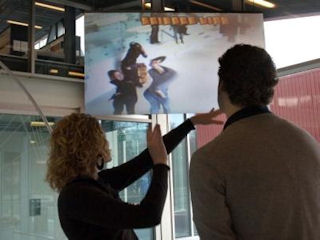Pixels and Pirouettes
There are many different reasons for doing natural science research. To gather knowledge, for example, or to contribute to society. Quite often, however, such research is done for no other reason than personal interest. The video filter created by Computing Science student Wicher Visser is a good example.

Recognising pixels
‘My field of research is “Computer Vision”, which is the automatic recognition of shapes in films,’ explains Wicher. He starts by separating the foreground and background (called segmentation) and then sees what he can do with the result. His research is part of the Intelligent Systems research group of the Institute for Mathematics and Computing Science (IWI).
Although Wicher is not the only researcher studying segmentation, he is the first in Groningen to use it for video images. ‘This makes it more interesting, but the dynamism makes it more complex too.’ Wicher continues: ‘An extra dimension is added, namely “time”. Pixels in video images change in time.’

Playing with the video image filter
The transition from a photo image filter to a video image filter was quickly made. You can see how it happened in the Science LinX exhibition. ‘I was actually kind of sidetracked at the time,’ explains Wicher. ‘I was just building a fun application to create cool effects for moving images,’ the fifth-year Computing Science student continues. Wicher was allocated the project by Nicolai Petkov, head of IWI as well as the Intelligent Systems research group. Both Nicolai Petkov and Wicher Visser derive their enthusiasm for the project purely from personal interest. ‘For the fun of it,’ so says Wicher. It wasn’t just fun to build; it’s fun to play with too, as demonstrated by the fact that both school pupils and professors spontaneously turn pirouettes in front of the video screen!

Practical applications
Although the video filter was initially developed just for fun, there are also a number of socially relevant applications conceivable. Wicher describes a couple: ‘Number plate recognition on motorways, for example, or surveillance cameras at remote industrial parks.’ A lot of money could be saved by replacing surveillance personnel with an automated system for detecting undesirable night-time visitors. The application searches for a moving object in a video image (the foreground), segregates this moving object from the rest of the image (the background), and can then proceed to monitor the moving object. ‘If you couple this application to face recognition software and link it up to a database with photos of criminals, the result will be a highly advanced automated security system,’ declares Wicher. Of course this leaves us with the question of whether we are willing to compromise privacy that far...

Audience
However, in Science LinX we keep it simple. You don’t have to worry about being traced, followed or registered. But do be aware that other visitors to the exhibition are watching as you play the fool in front of our camera!
Links
Acknowledgements
Special thanks to: Prof. Nicolai Petkov, Wicher Visser and Emiel Loer. Please contact Science LinX if you should have been included in the acknowledgements.
Author
Siëlle Gramser
| Last modified: | 01 October 2015 4.16 p.m. |

